Shortround6
Lieutenant General
The props were fitted by de Havilland teams, travelling across the country, just before the start of the Battle.
I believe that is partially part of the Spitfire 'legend'. There is little doubt that de Havilland teams did travel the country either fitting 'new' props or modifying the 2 pitch props to constant speed. The two pitch prop already had the pitch change mechanism. it needed a governor/control mechanism/system. The Legend rather ignores the The Spitfires and Hurricanes that had been built with Rotol propellers. The de Havilland teams (and squadron mechanics who did most of the conversions after being shown how by the de Havilland teams) did perform a valuable service in bringing large numbers of the older Spitfires (and Hurricanes) up to the newer standard.
There seems to be a bit of confusion as to what was happening when. At least two squadrons (19 and 54) had gotten their hands on a least a few Rotol Spitfires by Dec of 1939 even though the RAE completed a performance report in March of 1940.
The RAE compared a Rotol Spitfire to captured Bf 109 in June of 1940 yet a letter from air vice -marshal H.R. Nicholl on June 16 1940 states that to his understanding no Spitfires on the Supermarine production line had Rotol propellers.
Perhaps Supermarine was using DH props and a shadow factory was using Rotol props?

